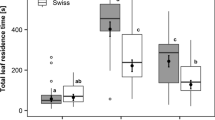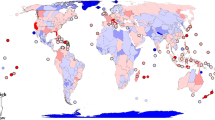Abstract
Introduced plants can positively affect population viability by augmenting the diet of native herbivores, but can negatively affect populations if they are subpar or toxic resources. In organisms with complex life histories, such as insects specializing on host plants, the impacts of a novel host may differ across life stages, with divergent effects on population persistence. Most research on effects of novel hosts has focused on adult oviposition preference and larval performance, but adult preference may not optimize offspring performance, nor be indicative of host quality from a demographic perspective. We compared population growth rates of the Baltimore checkerspot butterfly, Euphydryas phaeton, on an introduced host, Plantago lanceolata (English plantain), and the native host Chelone glabra (white turtlehead). Contrary to the previous findings suggesting that P. lanceolata could be a population sink, we found higher population growth rates (λ) on the introduced than the native host, even though some component parameters of λ were higher on the native host. Our findings illustrate the importance of moving beyond preference–performance studies to integrate vital rates across all life stages for evaluating herbivore–host plant relationships. Single measures of preference or performance are not sufficient proxies for overall host quality nor do they provide insights into longer term consequences of novel host plant use. In our system, in particular, P. lanceolata may buffer checkerspot populations when the native host is limiting, but high growth rates could lead to crashes over longer time scales.







Similar content being viewed by others
References
Bates D, Maechler M, Bolker B, Walker S (2014) Package Lme4: linear mixed-effects models using Eigen and S4. J Stat Softw 67
Bernays E, Graham M (1988) On the evolution of host specificity in phytophagous arthropods. Ecology 69:886–892
Bezemer TM, Harvey JA, Cronin JT (2014) Response of native insect communities to invasive plants. Annu Rev Entomol 59:119–141
Blossey B, Nötzold R (1995) Evolution of increased competitive ability in invasive nonindigenous plants—a hypothesis. J Ecol 83:887–889
Boggs CL, Freeman KD (2005) Larval food limitation in butterflies: effects on adult resource allocation and fitness. Oecologia 144:353–361
Boggs CL, Ross CL (1993) The effect of adult food limitation on life-history traits in Speyeria mormonia (Lepidoptera, Nymphalidae). Ecology 74:433–441
Boggs CL et al (2006) Delayed population explosion of an introduced butterfly. J Anim Ecol 75:466–475
Boughton DA (1999) Empirical evidence for complex source–sink dynamics with alternative states in a butterfly metapopulation. Ecology 80:2727–2739
Boughton DA (2000) The dispersal system of a butterfly: a test of source–sink theory suggests the intermediate-scale hypothesis. Am Nat 156:131–144
Bowers MD (1980) Unpalatability as a defense strategy of Euphydryas phaeton (Lepidoptera, Nymphalidae). Evolution 34:586–600
Bowers MD, Richardson LL (2013) Use of two oviposition plants in populations of Euphydryas phaeton, Drury (Nymphalidae). J Lepidopterists Soc 67:299–300
Bowers MD, Schmitt J (2013) Overcrowding leads to lethal oviposition mistakes in the Baltimore Checkerspot, Euphydryas phaeton, Drury (Nymphalidae). J Lepidopterists Soc 67:227–229
Bowers MD, Stamp NE, Collinge SK (1992) Early stage of host range expansion by a specialist herbivore, Euphydryas phaeton (Nymphalidae). Ecology 73:526–536
Brown LM, Crone EE (2016) Minimum area requirements for an at-risk butterfly based on movement and demography. Conserv Biol 30:103–112
Carey JR (2001) Insect biodemography. Annu Rev Entomol 46:79–110
Carpenter D, Cappuccino N (2005) Herbivory, time since introduction and the invasiveness of exotic plants. J Ecol 93:315–321
Caswell H (2001) Matrix population models, 2nd edn. Sinauer Associates Inc, Sunderland
Cavers PB, Bassett IJ, Crompton CW (1980) The biology of Canadian weeds: 47. Plantago lanceolata L. Canadian J Plant Sci 60:1269–1282
Chew FS (1977) Coevolution of Pierid butterflies and their cruciferous foodplants. 2. Distribution of eggs on potential foodplants. Evolution 31:568–579
Cornell HV, Hawkins BA (1995) Survival patterns and mortality sources of herbivorous insects: some demographic trends. Am Nat 145:563–593
Cornell HV, Hawkins BA, Hochberg ME (1998) Towards an empirically-based theory of herbivore demography. Ecol Entomol 23:340–349
Courtney SP (1981) Coevolution of Pierid butterflies and their cruciferous foodplants. 3. Anthocharis cardamines (L) survival, development and oviposition on different hostplants. Oecologia 51:91–96
Emlen JM (1966) The role of time and energy in food preference. Am Nat 100:611–617
Fei M, Gols R, Harvey JA (2014) Seasonal phenology of interactions involving short-lived annual plants, a multivoltine herbivore and its endoparasitoid wasp. J Anim Ecol 83:234–244
Fiske IJ, Chandler RB (2011) Unmarked: an R package for fitting hierarchical models of wildlife occurrence and abundance. J Stat Soft 43:1–23
Forister ML, Wilson JS (2013) The population ecology of novel plant–herbivore interactions. Oikos 122:657–666
Forister ML, Nice CC, Fordyce JA, Gompert Z (2009) Host range evolution is not driven by the optimization of larval performance: the case of Lycaeides melissa (Lepidoptera: Lycaenidae) and the colonization of alfalfa. Oecologia 160:551–561
Frye J, Durkin P, Gibbs D, Gibbs R, Lustig M (2013) Conservation and management of the baltimore checkerspot (Euphydryas phaeton drury) in maryland: strategies for statewide monitoring and for wetland restoration, captive breeding and release in the piedmont region. In: Frye J (ed) Maryland department of natural resources, wildlife and heritage service, Natural heritage program, Annapolis, Maryland, USA
Fuchs A, Bowers MD (2004) Patterns of iridoid glycoside production and induction in Plantago lanceolata and the importance of plant age. J Chem Ecol 30:1723–1741
Garcia-Robledo C, Horvitz CC (2011) Experimental demography and the vital rates of generalist and specialist insect herbivores on native and novel host plants. J Anim Ecol 80:976–989
Garcia-Robledo C, Horvitz CC (2012) Parent-offspring conflicts, “optimal bad motherhood” and the “mother knows best” principles in insect herbivores colonizing novel host plants. Ecol Evol 2:1446–1457
Gotelli N (2001) A primer of ecology, 3rd edn. Sinauer Associates Inc, Sunderland
Graves SD, Shapiro AM (2003) Exotics as host plants of the California butterfly fauna. Biol Conserv 110:413–433
Gripenberg S, Mayhew PJ, Parnell M, Roslin T (2010) A meta-analysis of preference–performance relationships in phytophagous insects. Ecol Lett 13:383–393
Holt RD (1985) Population dynamics in two-patch environments: some anomalous consequences of an optimal habitat distribution. Theor Popul Biol 28:181–208
Janz N, Nylin S (2008) The oscillation hypothesis of host-plant range and speciation. In: Tilmon K (ed) Specialization, speciation, and radiation: the evolutionary biology of herbivorous insects. University of California Press, Berkeley, pp 203–215
Keeler MS, Chew FS (2008) Escaping an evolutionary trap: preference and performance of a native insect on an exotic invasive host. Oecologia 156:559–568
Kéry M, Schaub M (2012) Bayesian population analysis using WinBUGS: a hierarchical perspective. Academic Press, Elsevier, Waltham, MA, USA
Kuussaari M, Van Nouhuys S, Hellmann JJ, Singer MC (2004) Larval biology of checkerspots. In: Ehrlich PR, Hanski I (eds) On the wings of checkerspots: a model system for population biology. Oxford University Press, New York, pp 138–160
Lei GC, Hanski I (1997) Metapopulation structure of Cotesia melitaearum, a specialist parasitoid of the butterfly Melitaea cinxia. Oikos 78:91–100
Levins R, MacArthur R (1969) An hypothesis to explain the incidence of monophagy. Ecology 50:910–911
Mayhew PJ (2001) Herbivore host choice and optimal bad motherhood. Trends Ecol Evol 16:165–167
Pearse IS, Altermatt F (2013) Predicting novel trophic interactions in a non-native world. Ecol Lett 16:1088–1094
Pickens BA, Root KV (2008) Factors affecting host-plant quality and nectar use for the Karner blue butterfly: implications for oak savanna restoration. Nat Area J 28:210–217
Pulliam HR (1988) Sources, sinks, and population regulation. Am Nat 132:652–661
Rodgers VL, Stinson KA (2008) Ready or not, garlic mustard is moving in: Alliaria petiolata as a member of eastern North American forests. Bioscience 58:426–436
Rodriguez LF (2006) Can invasive species facilitate native species? evidence of how, when, and why these impacts occur. Biol Invasions 8:927–939
Scheirs J, De Bruyn L, Verhagen R (2000) Optimization of adult performance determines host choice in a grass miner. P Roy Soc B-Biol Sci 267:2065–2069
Schlaepfer MA, Sax DF, Olden JD (2011) The potential conservation value of non-native species. Conserv Biol 25:428–437
Schoener TW (1971) Theory of feeding strategies. Annu Rev Ecol Syst 2:369–404
Severns PM, Warren A (2008) Selectively eliminating and conserving exotic plants to save an endangered butterfly from local extinction. Anim Conserv 11:476–483
Sih A, Christensen B (2001) Optimal diet theory: when does it work, and when and why does it fail? Anim Behav 61:379–390
Singer MC, McBride CS (2010) Multitrait, host-associated divergence among sets of butterfly populations: implications for reproductive isolation and ecological speciation. Evolution 64:921–933
Singer MC, Thomas CD, Parmesan C (1993) Rapid human-induced evolution of insect host associations. Nature 366:681–683
Singer MC, Wee B, Hawkins S, Butcher M (2008) Rapid natural and anthropogenic diet evolution: three examples from checkerspot butterflies. In: Tilmon K (ed) Specialization, speciation, and radiation: the evolutionary biology of herbivorous insects. The University of California Press, Berkeley, pp 311–324
Stamp NE (1979) New oviposition plant for Euphydryas phaeton (Nymphalidae). J Lepidopterists Soc 33:203–204
Stamp NE (1981) Effect of group size on parasitism in a natural population of the Baltimore checkerspot, Euphydryas-Phaeton. Oecologia 49:201–206
Stamp NE (1982) Searching behavior of parasitoids for web-making caterpillars—a test of optimal searching theory. J Anim Ecol 51:387–395
Stamp NE (1984) Effect of defoliation by checkerspot caterpillars (Euphydryas phaeton) and sawfly larvae (Macrophya nigra and Tenthredo grandis) on their host plants (Chelone spp.). Oecologia 63:275–280
Strauss SY, Lau JA, Carroll SP (2006) Evolutionary responses of natives to introduced species: what do introductions tell us about natural communities? Ecol Lett 9:354–371
Tepedino VJ, Bradley BA, Griswold TL (2008) Might flowers of invasive plants increase native bee carrying capacity? intimations from Capitol Reef National Park, Utah. Nat Area J 28:44–50
Thompson JN (1988) Evolutionary ecology of the relationship between oviposition preference and performance of offspring in phytophagous insects. Entomol Exp Appl 47:3–14
Van Nouhuys S, Hanski I (1999) Host diet affects extinctions and colonizations in a parasitoid metapopulation. J Anim Ecol 68:1248–1258
Wahlberg N (2001) The phylogenetics and biochemistry of host-plant specialization in melitaeine butterflies (Lepidoptera: Nymphalidae). Evolution 55:522–537
White GC, Burnham KP (1999) Program MARK: survival estimation from populations of marked animals. Bird Study 46:120–139
Wickman P-O, Karlsson B (1989) Abdomen size, body size and the reproductive effort of insects. Oikos 56:209–214
Williams EH (2012) Population loss and gain in the rare butterfly Euphydryas gillettii (Nymphalidae). J Lepidopterists Soc 66:147–155
Wolfe LM (2002) Why alien invaders succeed: support for the escape-from-enemy hypothesis. Am Nat 160:705–711
Yoon S, Read Q (2016) Consequences of exotic host use: impacts on Lepidoptera and a test of the ecological trap hypothesis. Oecologia 181:985–996
Acknowledgements
We thank the Conservation Commission of the town of Harvard, MA, for allowing us to use their land for our research. We also thank Aubrie James, Emma Sass, Natasha Tigreros, Norah Warchola, Ailene Ettinger, Lauren Redosh, Haley Coffman, Livia Baer-Bositis, Deane Bowers, Natalie Kerr, Dash Donnelly, Cheryl Schultz, Glenda Wardle, Michal Bodziewicz, and Rafal Zwolak for help with fieldwork. We are grateful to Richard Chandler for helpful advice regarding population models, and we are indebted to the Handling Editor and three anonymous reviewers for incredibly helpful comments and suggestions that greatly improved this manuscript. This work was supported by a National Science Foundation Award to LMB (DEB-1402287) and a Department of Defense SERDP Award to EEC (RC-2119), with additional support from Harvard Forest, Harvard University, and Tufts University.
Author contribution statement
EEC, GAB, and PMS conceived the original ideas and designed and carried out fieldwork conducted in 2012. LMB and EEC designed and carried out fieldwork conducted in 2013 and 2014. LMB and EEC collated and analyzed all of the data and wrote the manuscript.
Author information
Authors and Affiliations
Corresponding author
Additional information
Communicated by Roland A. Brandl.
Rights and permissions
About this article
Cite this article
Brown, L.M., Breed, G.A., Severns, P.M. et al. Losing a battle but winning the war: moving past preference–performance to understand native herbivore–novel host plant interactions. Oecologia 183, 441–453 (2017). https://doi.org/10.1007/s00442-016-3787-y
Received:
Accepted:
Published:
Issue Date:
DOI: https://doi.org/10.1007/s00442-016-3787-y




